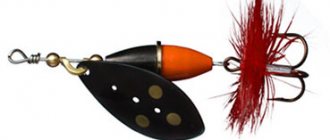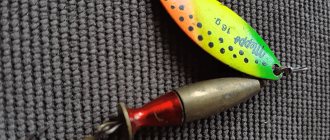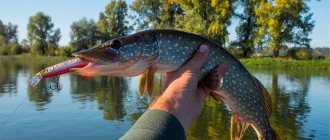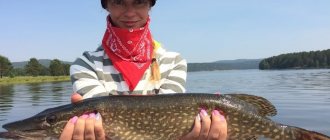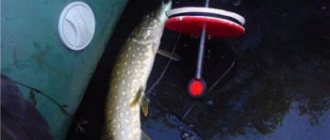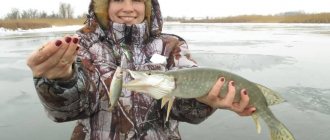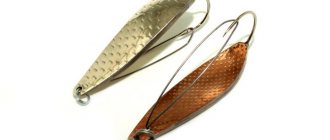NETOBSERVER.RU
Pike fishing is one of the most exciting types of fishing, giving a surge of adrenaline and a storm of emotions from fighting a toothy freshwater predator.
This process requires skills, dexterity and knowledge about your potential prey. Videos help you find out how a pike attacks, see its behavior live, and understand what ultimately attracts the predator. There are a lot of videos on YouTube - both just a pike attack, filmed by ordinary fishermen from a boat or from the shore, and underwater footage of a pike attack on a live bait or wobbler. It is very exciting to watch what is happening, both out of simple interest and by making certain “notes” for yourself in terms of how best to imitate the natural behavior of a pike “victim”. So, let's start watching. The first video is carefully compiled from 5 different moments of a pike attack. Moreover, these are not episodes of fishing, but unique moments of hunting of a toothy predator in natural conditions. The quality of the image is reminiscent of the good old VHS days, but this does not diminish the entertainment value.
The next video shows us the behavior of a pike that was “presented” with an imitation of a slowly swimming wounded fish. We can observe how a predator studies its potential prey, and not from one angle, but from several at once. This underwater video will end with a lightning-fast attack of pike on such a unique “live bait”.
Video No. 3 from the same channel “Underworld Ireland”. In it we will learn how pike behaves during more active fishing, as well as what color (and shape) of the bait it prefers. Here underwater life is more active (even though the region is the same - Ireland), so it will be spectacular:
And here’s how pike attacks in a body of water with a current. Either running water motivates the fish to take more active action, or the predator really liked the bait used. One way or another, in this underwater shooting the number of pike attacks is noticeably higher. Unique shots are obtained by combining underwater photography and video from the water's edge - this is what happens when you hear a loud splash, and then only have time to see powerful circles spreading out on the water surface:
No. 5 – another compilation of some episodes. Here you can see underwater photography, a pike attacking ducklings at the surface of the water, and an attack on a cat, which was already present in this review. But some replays are worth going through for unique shots: have you seen how a pike swallows a fellow almost the same size as itself? What about pike in the aquarium? Would you like to have a similar “pet” for yourself?
Video No. 6 simulates a rather unusual situation. You already have a good idea of the behavior of pike when guiding a wobbler/vibrotail or live bait - i.e. reaction to bait in motion. What if the “live bait” is practically static, but at the same time quite active? How is this even possible and how did this result in a video of a pike attacking live bait - see below:
In video of pike attacks on YouTube No. 7, we will touch upon such an unpleasant topic as cannibalism. Yes, pikes are not averse to feasting on their own relatives. This is how it is - the harsh and dangerous world of freshwater depths - even the presence of sharp teeth does not guarantee your survival!
Our selection has not yet included filming of a pike attack underwater in winter. How does she react to the bait lowered from the hole? What does this “under-ice kingdom” even look like? In video No. 8 there will be a hole, crucian carp using live bait as bait, and large pikes as the main characters. Camera - motor:
Continuing the “under the ice” theme – a real thriller. It did not receive hundreds of thousands of views, but it was decided that this video must be present in our review. A three-minute action-packed short film entitled “Who Turns Off the Bite” is presented to your attention. The video would ideally be accompanied by some disturbing soundtrack from a thriller or horror film about a huge and dark monster. In this case, the monster of the depths will be “she”:
How to fish with oscillating spoons?
Oscillating spoons are considered quite old gear, used for more than one century. This is gear that has undeniable advantages over other fishing equipment.
If you are fishing for pike with a spoon in a strong current at a depth of up to 2 meters, it is best in this case to use bait that is larger in size and of sufficient weight; the lightweight bait is carried away by the current.
You should not use cheap Chinese-made spinners; it is better to use high-quality tackle with sharp domestic-made hooks when catching pike on a spoon.
In a clear reservoir, it is best to use a bait of a natural color that does not repel predators; for muddy, dark-colored water, shiny bright baits are best suited.
Oscillating spoons are divided according to their shape and their movement in the reservoir:
Rotating rig , this type of bait rotates around its longitudinal axis and attracts the attention of pike in clear spring or summer water, free of weeds;
Swinging bait , this type of fishing tackle swings evenly in different directions, this type of spinner is considered the most catchy when fishing for pike in the autumn season;
Combined spoons , this type of gear swings and rotates at the same time, they are used at any time of the year;
Triangular oscillating spoons performed well during winter fishing in holes .
Fishing with a spoon. Pike at a long distance. Video
Fishing for pike in winter from ice
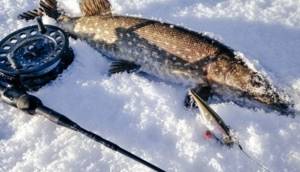
As winter approaches, fishermen begin to actively hunt for predators, including pike. The richest catches occur in the autumn, but the onset of the ice season complicates the fishermen’s task in catching the toothy predator, which requires a lot of patience and endurance.
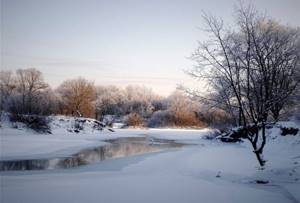
How to find pike in winter
Winter fishing for pike begins with searching for this predator, which is quite a difficult task. During the entire freeze-up, pike has the habit of changing its habitat, which depends on the presence of small fish suitable as food for it. When searching for pike, you need to take into account many details, because if there are no small fish in the fishing areas, the result may remain zero.
On the river
If it is a large river , then you should look for pike in snags or coastal bays, where the water is not so cold. In deep winter, pike most often stay at a depth of 1-2 meters, and towards the end of the cold period they begin to move closer to the shore.
In small rivers, snags, thickets of reeds or fallen trees can become the most catchy areas for pike hunting.
In winter, it is best to catch pike in the morning and evening at dawn, although you should not discount day and night fishing. Often, active biting that begins in the morning can turn into a daytime hunt for a predator.
Video: Catching pike in winter with ratlins
On a pond, lake
Fishing for pike in a pond is somewhat different from hunting on a river or reservoir. On a pond, pike usually do not swim long distances. In order to more accurately determine its location, it is necessary to study the so-called “pike trails”. If the pond has deep cliffs on the banks, then most often the pike will be located in the roots of coastal trees, where it is convenient for it to catch small prey. If it is a body of water with a relatively flat depth level, then the predator will not concentrate in certain areas, which will complicate the fisherman’s search task.
On the lake, pike most often gather in schools, waiting for prey in ambush with dense vegetation. In winter, pike can be located in deep dumps, which provide the best feeding areas for predators. More experienced fishermen are usually aware of such places, so it will not be difficult for them to find pike.
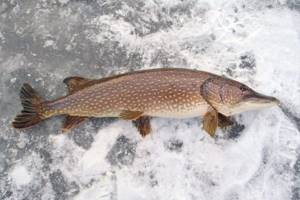
Photo: Pike in winter
At the reservoir
The reservoir is considered the most successful place for pike fishing in December, with the onset of the ice season. At the same time, it bites best on live bait rather than on artificial bait.
During this period, there is a current between the forested areas of the reservoir, in which there are enough small fish to attract the attention of predators. Pike also bite well during the thaw period, as it confuses the spring and winter seasons and begins to bite especially actively.
If we talk about the reservoir, it should be noted that with the onset of cold weather, pike do not stay in coastal waters. Even wooded and shallow areas rich in snags do not attract fish. Although during the thaw period and first ice, such zones are quite promising for a rich catch. On cold days, there is less oxygen in these places, algae die off, old remains of stumps rot at the bottom, and there is almost no current.
That is why pike and other predators often leave these places, gradually moving to the waters of large rivers, where even when the flow stops, large roach appear, which attracts predators. These areas are considered the most optimal place for winter pike fishing.
Winter fishing for pike on girders
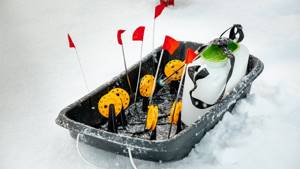
Our dear fishing friends, in previous articles we told you about how to catch pike in winter using balance beams
, and now we want to tell you about catching pike on girders in winter.
To successfully catch pike on the girders, it is not enough to arrive at the selected reservoir with suitable equipment and place flags in the first available place near the bushes. It is easy to catch a spotted predator only where there is a lot of it and the body of water is not subject to constant attacks from anglers.
You will need to know the habits, nuances of winter migrations and nutrition of pike. We'll tell you how to catch it correctly and effectively during this period.
Set of vents on a stand ZhZ-03 Tonar 1,060 for 1 piece. A set of vents on a stand equipped with ZhZO-02M (d-185mm, d-85mm coil) (10 pcs) Tonar 1,765 for 1 pc. Zherlitsa on a stand ZhZ-02M Tonar 80 for 1 piece. Zherlitsa on a stand ZhZ-04 Tonar 77 for 1 piece. Zherlitsa on a stand equipped with ZhZO-04 (d-185mm. coil d-63mm) Tonar 156 for 1 pc. A set of girders with a corner post in a bag with colored spools d.85-90 Three whales 102.70 for 1 piece. Zherlitsa on a stand equipped with ZhZO-02M (d-185mm. coil d-85mm) Tonar 162 for 1 pc. Vine with stopper Three pillars 86 for 1 piece.
Select a zherlitsa
Fishing with girders is one of the most effective ways to catch pike in winter. During the first ice, thaw and during the last ice, pike fishing gives excellent results, and also if the reservoir has already been explored by you. And in the middle of nowhere, when predators are already very passive, it is garrison fishing that allows you to stir up the toothy bandit and provide you with a good catch. The main advantage of this type of fishing is live bait instead of artificial bait.
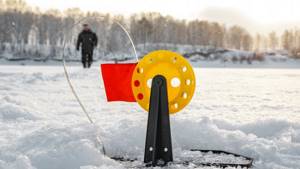
Several factors influence the activity of pike and its bite:
- Feed base
- Oxygen supply
- Migrations in winter (depend on the first two points, as well as movements at the end of freeze-up, for spawning)
- Water level in the reservoir
- Weather
It is almost impossible to determine what kind of weather influences the behavior of pike when fishing with girders. After all, each forecast is designed for a specific body of water and a specific area. But even in the most unfavorable weather conditions, there will still be a pike that will be tempted by the bait, despite the fact that others will neglect it.
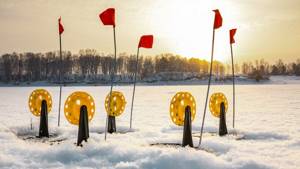
So what weather is most favorable for catching pike on a girder?
For successful pike fishing on girders, the weather is considered favorable if it is smooth, without surges in atmospheric pressure. With sudden changes in the state of the atmosphere, fish need time to adapt. Optimal conditions for pike biting on girders in winter:
- Light frost for several days in a row
- Frosty clear days
- Thaw lasting several days
But taking these recommendations as a strict rule would be a mistake. After all, a pike is a living organism that obeys its own desires. And if she gets hungry in unsuitable weather for girder fishing, she will hunt.
It is important to catch the weather dependence of the pike bite in a particular body of water.
In winter, pike constantly moves after its food supply and in search of favorable oxygen conditions.
With the onset of winter, check all dumps, shallow water, snags, and bushes.
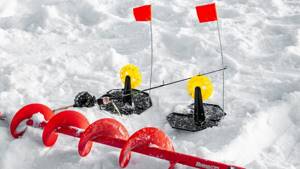
Varieties of girders
You can catch pike in winter using both under-ice and above-ice traps. Let's consider both options, their pros and cons.
Overglacial vent
This is the most universal type that is used everywhere. The vent on a flat base is easy to install; thanks to the bracket, a flag and a coil on a leg are mounted on it.
Advantages:
- ease
- compactness
- ease of use
- the water in the hole freezes more slowly due to the fact that the platform of the girder protects it from the wind
- This kind of girder can be installed on ice of any thickness
- The girder blocks the sunlight in the hole, so the fish behaves less carefully.
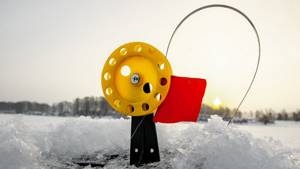
Flaws:
- during heavy snowfalls the signal flag is difficult to see
- in gusty winds, it is necessary to sprinkle the platform with snow
- the platform of the vent can freeze into the ice, so you need to pay attention to the correct installation
Sub-ice vent or supply
As the name suggests, such girders are placed under a layer of ice.
Advantages:
- can be installed for a long period, for example, overnight
- small size
- possibility of self-hooking fish
- It’s convenient to fish in the cold because you don’t have to constantly clear the hole of ice
minus – no signal flag
Gear equipment
To effectively catch pike from the ice, you need to understand how to properly equip the girder. The equipment consists of a reel, fishing line, leashes with a swivel, hook and sinker. If you fish in shallow water, a sinker is not necessary.

Reel and line
For winter fishing, a plastic reel with a sufficient supply of fishing line is better suited if you plan to fish at depth. Choose a monofilament line that is reliable and elastic. Don’t skimp, a cheap fishing line can let you down at the most crucial moment. For fishing, do not take a cord, firstly, it freezes quickly, unlike monofilament fishing line, and secondly, when fishing, you can seriously injure yourself with it. The diameter of the line for small pike is 0.25 mm, for larger specimens or fishing in snags - 0.3-0.35 mm.
Line XILO 50 m COLMIC 585 for 1 piece. Line WILDCAT 50 m (winter) YGK 363 for 1 piece. Winter fluorocarbon fishing line TAKEDO White Fluo TAKEDO 188 for 1 pc. Winter fishing line SKYLINE Fluorocarbon Composition IceTech PRO Neon 50 m Sprut 151 for 1 pc. Fishing line Expert profi Nano Poliamide Colection X5 30m EXPERT 176 for 1 pc. Winter fishing line SKYLINE Fluorocarbon Composition IceTech PRO Blue 50 m Sprut 151 for 1 pc. Expert Profi Crustal fishing line 50 meters EXPERT 242 for 1 piece. Monofilament fishing line Kamiki (B) 50 m 480 per 1 piece.
Buy winter monofilament
Leashes and hooks
It is better not to neglect the leash, because in the event of a snag in a snag or a trophy fish being bitten, it guarantees the safety of the tackle. If there is an understanding that in the selected area the fish is behaving aggressively or there are trophy specimens, then it is better to take a metal or tungsten leash, but if the pike is sluggish and passive, then you can get by with fluorocarbon.
Leash equipped dl. 25cm. test 15kg. PIERCE 30 for 1 piece. Fluorocarbon leash 0.5mm 13.8kg 35cm (HS-0057) Helios 95 for 1 pack. Fluorocarbon leash 0.6mm 16.5kg 20cm (HS-0064) Helios 105 for 1 pack. Leash equipped dl. 25cm. test 9kg. PIERCE 20 for 1 piece. Fluorocarbon leashes (20cm/0.50mm/11kg) 1pack*3pcs Sprut 240 per 1pack. Leash equipped dl. 20cm. test 9kg. PIERCE 20 for 1 piece. Leash equipped dl. 20cm. test 15kg. PIERCE 30 for 1 piece. Fluorocarbon leashes (20cm/0.70mm/18kg) 1pack*3pcs Sprut 240 per 1pack.
All leashes in the catalog
Select high-quality bait hooks, reliable, with sharp stings; it is unacceptable for the hooks to unbend during fishing. Both tees and doubles are suitable for this predator.
Triple hook (HS-ST-36-5) Helios 21 for 1 pc. Triple hook 13-10-10-386 /ST-36BC-18 OWNER 360 for 1 pack. Triple hooks Round Treble art. KH11030-2/0/1 Rubicon 680 for 1 pack. Tee No. 2 15 for 1 piece. Triple hook (HS-ST-36-1) Helios 24 for 1 pc. Triple hook ST-36BC-08 OWNER 360 for 1 pack. Triple hook (ST-36RD-16) OWNER 435 for 1 pack. Triple hooks “Sprut” Kawa ST-31 BC #2 (Treble Wide Gap Hook) 1pack*6pcs Sprut 380 for 1 pack. Triple hook (HS-ST-36-16) Helios 30 for 1 pc. Triple hook ROUND (3R-BLN-01) METSUI 975 for 1 pack.
Tees in assortment
Sinker
It is preferable to choose a sliding type load; one sinker is enough for each girder. To avoid snags, you should choose a sinker in the shape of an ellipse, weighing 6-10 grams, for a standing reservoir; on a river, the load is selected according to the strength of the current.
Signal flags
Ready-made girders are often already equipped with flags, but fishermen can replace them at their discretion. In the dark, it is recommended to cover the flags with a luminous composition (phosphorus varnish or firefly); you can also use a bell with a firefly
.
Zywiec
Despite the apparent similarity of all the small fish, pike has its own preferences. The pike most readily takes on:
- silver bream
- perch
- roach
- minnows
- char
IMPORTANT! You only need to catch live bait in the same body of water in which you are going to catch pike. This will be her usual food and will not cause alertness. While live bait caught in other places will differ in both smell and appearance, pike can be careful and try their luck away from suspicious prey.
The most tenacious is crucian carp, but the predator is more attracted to silver bream and roach. The bait method also affects the activity of live bait:
We pass a leash through the gills into the mouth; this is a less traumatic option for live bait. Next, you should attach the hook to the leash and insert the fore-end into the baitfish’s mouth. We pass the hook through the dorsal fin, but carefully - you cannot touch the ridge, otherwise the inactive baitfish will not attract the pike. This method requires perfect hook sharpness.
Black live bait can 10 liters Helios 320 for 1 pc. White live bait can 10 liters Helios 320 for 1 pc. Can for live bait 8 liters KO-8 Three whales 473 for 1 piece. Jaw grip for fish 25.5 cm Helios (HS ZR-25.5 HSP-694) Helios 420 for 1 pc. Hook telescope 3 count. No. 1 600 mm, 105 g PIRS 441 for 1 piece. Jaw gripper for fish metal Helios (HS-KD-0058) Helios 860 for 1 pc. Fishing forceps 18cm (HS KL-18) Helios 455 for 1 pc. Zevnik (HS-XC-0080) Helios 82 for 1 pc. Telescopic aluminum hook with plastic handle (15204) Three whales 164 for 1 piece. Zevnik (HS-XC-0081) Helios 82 for 1 pc.
Installation of the vent
It is better to place the zherlitsa in one line, leaving a distance of 20-30 meters between them, but in the dead of winter you can leave less - 10-15 meters is enough, since the spotted beauty is inactive at this time. But remember - the minimum distance between the girders depends on the depth of the reservoir and the speed of the current. If you understand that promising places are not on the same line at all, but, say, on a rounded patch, then the girders can be arranged in a checkerboard pattern.
Stages:
The depth in a specific hole is measured
For successful fishing, keep live bait 5-15 cm above the bottom surface. To calculate the distance, first lower the fishing line with a load without live bait, release the fishing line as much as necessary, make an adjustment by 5-15 cm and fix the reel with fishing line with a flag
Live bait is attached to the hook using the chosen method.
We lower the live bait to the selected depth and install the girder on the hole

Fishing technique
Pike is a strong opponent, and even an experienced fisherman will have to try hard to catch it.
Bite
When fishing with girders, there are two phases of bite:
Capture
The pike attacks, grabs the bait and freezes for a few seconds. At this time the flag is activated. Next, the predator tries to go into shelter with your live bait, at this time the fishing line unwinds.
Swallowing live bait. The spool reel stops. At this moment, the predator turns the bait with its head inward and slowly swallows it. Then he tries to leave with hooks in his mouth.
Sweeping
At the moment of the bite, there is no need to rush into hooking; unnecessary fuss around the triggered flag will not bring any benefit. It’s worth hooking only when your fishing rod reel starts spinning for the second time. Otherwise, you will simply pull the bait out of the pike's mouth.
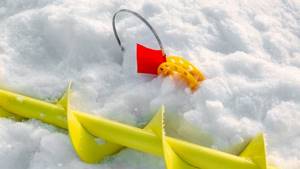
Fishing
But it’s not enough to hook correctly, you also need to correctly pull out the trophy. After you have successfully hooked, do not let go of the line, do not give up any slack, light tension is necessary, otherwise this trick will easily go into the snags, tangle and break the line. But you don’t need to pull too hard, since in this case there is a risk that the stretched line will simply break either on the sharp edge of the ice or on the teeth of the fish itself.
If the fish is not large, we fish it out right away, but if you come across a trophy pike, then give it the opportunity to get tired, since you may simply not be able to cope with it. We release the pike with a slight pull, then pull it towards us, smoothly braking. When the predator appears in the hole, use the hook. And watch your fingers more carefully - pike teeth are not just for beauty. In order to remove the hook from the mouth and prevent yourself from being bitten, have with you a yawner and forceps for pulling out hooks.
Despite the very simple equipment and no less simple design, the girder is worthy of respect, since even a beginner can handle it, and fishing will be, if not at a high, then at an acceptable level, even without proper experience.
There is an opinion that if a pike is pulled out of one hole, then there will be no more bite here, since this predator has its own hunting area, and only after a few days another fish may appear in this place. But this is not always the case, especially in large water areas, the fish walks wherever it wants. Therefore, reload the tackle and leave it on the same hole. It is often possible to pull out several pikes from one hole in a day.
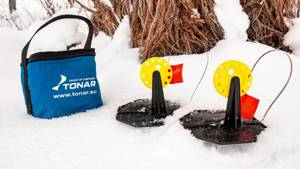
What you need for winter pike fishing
The optimal fishing location and good bait have a great influence on the quality of the catch, but special attention also needs to be paid to the angler’s equipment. As already noted, gear for pike fishing in winter must be especially strong and reliable, since ice fishing requires considerable skill.
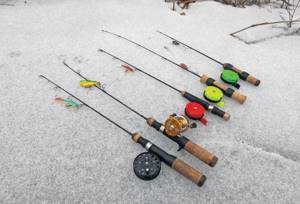
Tackle (rod, line, reel)
To catch pike you will need the following gear:
- A rod for catching pike should be strong enough, more than 30 cm long. A nod for pike is not required, but a small hard nod may be needed for a small predator.
- For pike, it is better to use monofilament fishing line, the thickness of which depends on the size of the fish; on average, its diameter should be 0.2-0.4 mm. The bite of large individuals is also possible, so the strength of the fishing line is of no small importance. Some people prefer to use braided line, but in winter water it becomes noticeable and can cause a poor catch.
- The reel can be any type; a reel is most suitable.
- Any type of hook is suitable for pike fishing, the main thing is their strength and suitable size.
- It is better to use metal leashes, for example, made of tungsten.
Posting an oscillating spoon when fishing for pike
Catching pike with a spinner spoon is possible in two ways: uniform and uneven fishing.
When fishing for predators in shallow, transparent reservoirs and holes with a clean bottom, after lowering the bait, you need to pause for about thirty seconds to one minute, and then retrieval, this technique is called “Pause”.
Uniform reeling or “pulling” is a method in which the fishing line is reeled in evenly at the same speed, and the end of the spinning rod is in a stationary position, and the depth of the tackle does not change. Uniform wiring allows the fisherman to catch a larger number of pikes at the moment when it hunts the inhabitants of the reservoir.
When the retrieve is uneven or jerking, the fisherman seems to be playing with the predator, provoking it by making jerking movements with the top of the spinning rod to the sides and up.
Pike on oscillating spoons in the fall. Technique for placing a spinner on video
The influence of weather on pike biting in winter
Pike is considered one of the most weather-sensitive freshwater fish. Its activity can be affected not only by magnetic storms, but also by changing phases of the moon, wind direction and many other weather parameters.
Pressure
The pike shows maximum activity when the pressure remains stably at the same level for several days. It doesn’t matter whether it is high or low. But sharp jumps (from 5 mm Hg or more) do not contribute to a good bite, as well as its prolonged increase or decrease, which lasts for three or more days.
Temperature, wind, precipitation
In strong winds, pike practically stop feeding, so even the slowest baits will not be able to tempt it. Low temperatures also negatively affect the activity of the toothed predator, since a slow metabolism allows them to consume less food. Light snowfall does not have a significant impact on the quality of fishing, but severe and frequent frosts are considered an unfavorable period for fishing.
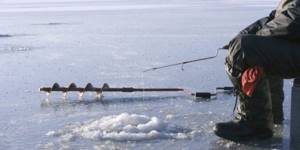
Optimal weather for pike fishing in winter
The most favorable conditions for pike fishing are cloudy weather with weak wind and stable atmospheric pressure.
Features of winter fishing by month
Although the Russian climate is not considered the most comfortable, winter nevertheless opens up wide scope for ice fishing for fishermen. In winter, fish not only change their behavior, but also their habitat, so fishing methods need to be adjusted to these indicators.
December
December is the most optimal month for winter predator hunting. This time is characterized by greater freedom of movement, especially on large bodies of water. From shallow waters, fish move to deep places. However, the ice in December is still transparent, so you should move on it with extreme caution, and fill the holes with snow. The best times for catching large pike are the first 3 weeks of December.
January
Experienced fishermen note that at the end of January and throughout February, the release of pike practically stops, since the dead winter or dead season for fisherman begins in many reservoirs. During this period, you need to constantly change your fishing methods and make efforts to lure half-asleep fish.
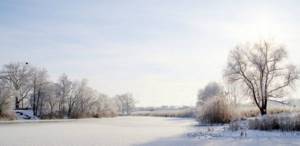
What to use to catch pike in January
Fishing in January brings more disappointment than catch, but the catch is especially valuable. In January, pike continue to be caught using spoons and jigs.
February
In the last month of winter, fish hibernation still continues, so possible prey is caught with the thinnest gear. Pike can be caught during the thaw, in the early morning hours and in the evening. The first half of February is considered the least suitable period for winter pike hunting.
Color of the spinner. What color is the most popular?
When choosing the color of a spinner, you need to remember that there is no specifically recognized color.
You need to select 2 types of bait:
Provocative color shade , it has an irritating effect on the predator; it is green, yellow and orange in color;
Natural colors that imitate natural fry are silver or bronze colors.
Another positive aspect for lure fishing is the presence of a small red flag at the end of the tackle. Provocative colors do not resemble potential victims of the predator, but they act as a strong irritating element, causing an attack by the pike.
3 ways to improve your fish bite!

Over 15 years of active fishing, I have found many ways to improve the bite, and here are the most effective:
1. Bite activator . This pheromone additive attracts fish most strongly in cold and warm water. The Fish Hungry bite activator has proven itself to be excellent - Read more…
2. Tackle with increased sensitivity . You should first familiarize yourself with the features of using a particular type.
3. Pheromone baits . They attract the attention of fish, stimulate hunger and cause a schooling reflex, which allows you to collect a lot of fish in one place.
You can get the rest of the secrets of successful fishing for free by reading my other materials on the site.
3 ways to improve your fish bite!
Over 15 years of active fishing, I have found many ways to improve the bite, and here are the most effective:
1. Bite activator . This pheromone additive attracts fish most strongly in cold and warm water. The Fish Hungry bite activator has proven itself to be excellent - Read more…
2. Tackle with increased sensitivity . You should first familiarize yourself with the features of using a particular type.
3. Pheromone baits . They attract the attention of fish, stimulate hunger and cause a schooling reflex, which allows you to collect a lot of fish in one place.
You can get the rest of the secrets of successful fishing for free by reading my other materials on the site.
